
An Illustrated Guide to the Science of Influence & Persuasion
The author's views are entirely their own (excluding the unlikely event of hypnosis) and may not always reflect the views of Moz.
Conversion rate optmization - the practice of improving the quantity of visitors who take a desired action on your site - has been a hot topic this year. There's both an art and a science to the process of turning browsers into buyers and drive-by readers into email subscribers, Facebook fans and Twitter followers. In my opinion, no marketer should be engaging in this work without having read Robert Cialdini's seminal work - Influence: Science & Practice. I agree wholeheartedly with Guy Kawasaki's assessment on the subject:
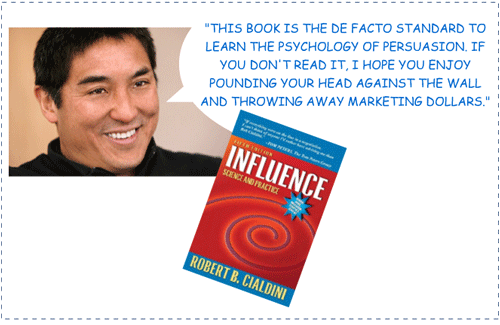
The problem is, not every marketer will read the book, and that leaves a lot of head-shaped holes in a lot of walls. Thus, this post is here to help do the next best thing - explain, through illustrations and descriptions, the broad concepts of persuasion. The book covers six major "weapons of influence." For each, I'm going to illustrate the concept then give tips (and some examples) on how you can apply them to marketing and conversion on the web.
#1 - Reciprocation
Hold open a door and you receive a "thank you" and a smile. Send a birthday present to a friend and you're almost certain to get one in return. Pay for a co-worker's coffee and she'll pick up the next one. As Cialdini painstakinly details in the book, there is no culture on Earth without this unspoken, yet powerful rule of reciprocation.
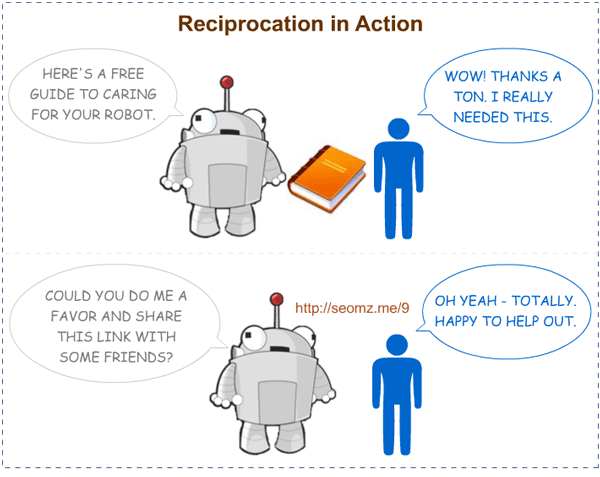
The power of reciprocation relies on several conventions. The request must be "in-kind," which is to say, commensurate with the initial offering. The power is increased if the give-and-take happens in a short time frame. Reciprocity's influence increases with closer relationships, too - it's much harder to resist/refuse to reciprocate a favor to a friend who's down the street than to an anonymous site on the web.
Leveraging reciprocity through web marketing:
- Give away free data and analysis through tools, but ask for permission to send an email marketing message in exchange
- Tweet or blog about a prominent person or business in a positive fashion, then email them asking if they'd help spread the message
- Email a site owner about a problem on their site and offer a solution/fix; they'll often follow up by asking how they can return the favor
- Provide exemplary answers to questions posted in online forums with a signature or final note asking that if they found your answer valuable, to consider visiting your site and sharing it with friends
- Share great information on your blog and ask your readers to subscribe to your feed (see what I did there? :-) Pretty meta, eh?)
#2 - Commitment & Consistency
As humans, we have an insatiable desire for consistency in our behavior. It's why we abhor hypocrisy and embrace leaders, politicians and beliefs that "stick to their guns," sometimes to the point of foolishness. This consistency can be observed through the effectiveness of political tactics like push polling, wherein a paid "surveyer" will call numbers and ask voters whether they'd cast a ballot for "a man who refused to say the pledge of allegiance," thus getting a response and commitment verbally that will transfer into votes come election day after the follow-on ad campaign alludes to precisely that inaction from an opposition candidate.
A case study from the book illustrates this principle quite elegantly. Researchers on a New York City beach staged thefts to see if onlookers would risk personal harm to stop the "criminal." A research accomplice would listen to music on a blanket near their "test subjects" and after several minutes, stand up and stroll away, leaving a personal radio on the blanket. A "thief" would then approach, grab the radio, and attempt to hurry away with it. On average, only 4 in 20 bystanders would intervene.
However, when the experiment was changed slightly, the results altered dramatically. In this second scenario, before strolling away, the research accomplice would ask the test subject to "watch my things." Now, under the influence of consistency and commitment, 19 of 20 subjects became "virtual vigilantes, running after and stopping the thief, demanding an explanation, often restraining the thief physically or snatching the radio away."
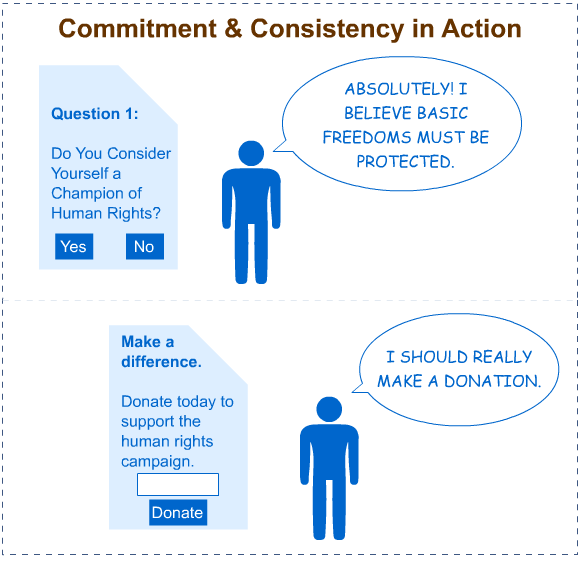
Commitment and consistency can't happen without that initial action of a reponse or promise. Cialdini notes that this power increases tremendously if the agreement is written, rather than merely verbal. E.g. last week, you told us you wanted XYZ... Guess what? Here it is!
Leveraging commitment and consistency through web marketing:
- Asking users to answer online questions about their habits/preferences, then marketing to them based on the answers they've given
- Getting visitors to a site to sign an online pledge to take a certain action and then email/message them at a specified day/time (example - the "Quit Facebook Day" movement)
- Asking your users/members/fans to commit to taking an action if a certain event occurs (like a charity pledge for a marathon runner). For example, you could say that your startup is up for an award and if you win it, you'd like them to commit to emailing a friend about their service. If/when you do win, send members who commited an email requesting the action.
- Using a landing page / funnel process that asks a question where users must choose to define themself in a set number of ways, then crafting sales messaging that speaks to how your product/service is the right choice for people like them.
#3 - Social Proof
If you're walking along a street and see a crowd gathered around watching something, it's nearly impossible to resist the urge to go over and investigate yourself. If you're at a party and everyone is drinking, the pressure to have a drink yourself rises dramatically. We all hate the horrifyingly over-the-top laugh tracks on TV sitcoms, but TV producers know that the social signal of laughter makes us laugh along, too.
This same phenomenon applies when we judge exceptionally important life decisions - who should we date or marry, where should we go to school, where should we work. The influence of our peers is a powerful influencer and one that can't be overlooked in the sphere of marketing.
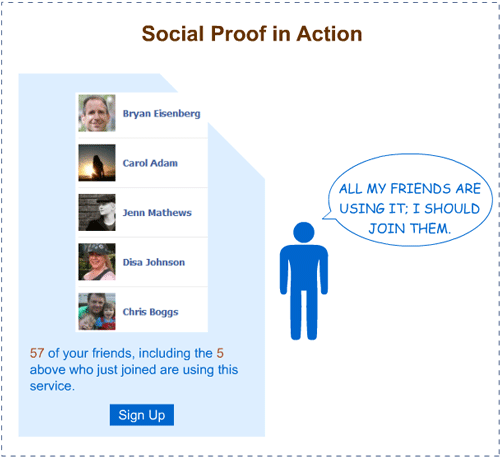
Social proof becomes more powerful when the numbers increase and when the action-takers become more relevant and, especially more like the target. In other words, if you're selling games to rebelling teenagers, don't show testimonials from middle-aged parents who loved it, show other teens.
Leveraging social proof in web marketing:
- Services like MyBlogLog that display the picture and username of recent visitors to the site
- Facebook-leveraging visit tracking software that shows recent friends of yours who've engaged with the site you're visiting (even more relevant and social proofy)
- Testimonials on landing pages and in sales copy. Those that feature photos, have titles and full names and relate to the visitor work best
- Network-effect services like Facebook, Twitter and LinkedIn touting their fast-growing and far-reaching memberships and usage
#4 - Liking
We've heard the phrase a thousand times - "People do business with people they know, like and trust." It turns out, there's quite a bit of science to support this. Research confirms that things like physical attractiveness (we like good-looking people), familiarity (we trust people we know), similarity (we like people like us) and compliments (we like people who say nice things about us) all factor into to the principle of "liking."
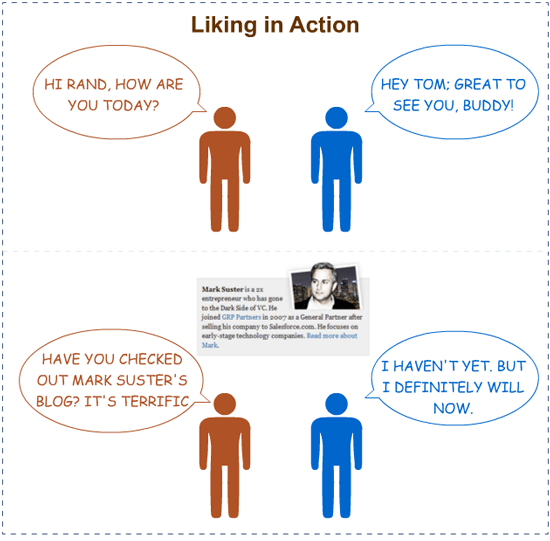
It's hard to argue with the power "liking" has on us as consumers. When Will Critchlow (whom I like a lot, despite constantly losing presentation-off battles to him) recommends that I read a book or try a service, it's practically a guarantee I'll do it (note to Will: please don't abuse this power). Similarly, movie executives realize that asking Tom Hanks to go on the late-night circuit is a great way to drive viewership of a film, while sending Tom Cruise on a similar mission may have the opposite result.
Leveraging liking in web marketing:
- Start a blog, twitter account or email list and share your thoughts in a personable, personal and friendly way.
- Employ the power of celebrity, in microcosms. If Seth Godin wrote a blog post saying that SEOmoz was a valuable resource, that would likely drive many people who like Seth to take commensurate actions.
- Join in conversations on the web (on forums, in blog comments, on Twitter, via other social services) in ways that engender you positively to those community members. Follow up personally with community leaders and organizers to help spread the liking effect in a more scalable way.
#5 - Authority
A story from the book illustrates this principle so well, I couldn't resist sharing:
Professors of pharmacy Michael Cohen and Neil Davis attribute much of the problem to the mindless deference given to the "boss" of a patient's case: the attending physician. According to Cohen, "in case after case, patients, nurses, pharmacists, and other physicians do not question the prescription." Take, for example, the strange case of the "rectal earache" reported by Cohen and Davis. A physician ordered ear drops to be administered to the right ear of a patient suffering pain and infection there. Instead of writing out completely the location "Right ear" on the prescription, the doctor abbreviated it so that the instructions read "place in R ear." Upon receiving the prescription, the duty nurse promptly put the required number of ear drops into the patient's anus.
Obviously, rectal treatment of an earache made no sense, but neither the patient nor the nurse questioned it. The important lesson of this story is that in many situations in which a legitimate authority has spoken, what would otherwise make sense is irrelevant. In these instances, we don't consider the situation as a whole but attend and respond to only one aspect of it.
The power of authority can come from a variety of sources - clothes (think of the movie "Catch Me if You Can" in which Leonardo DiCaprio becomes a doctor or pilot simply through attire), titles and prefix/suffixes (Dr., Senator, President, C-level executive), and context (the famous Milgram study in which ordinary people commit horrifying acts simply because they are told to do so).
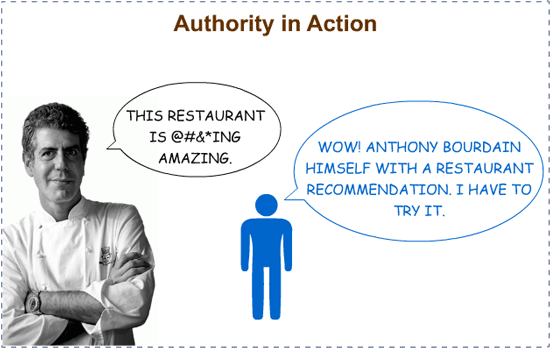
Authority only influences when the target believes in the power and authenticity of that authority. The stronger the authority association, the more powerful the impact, but not all authorities work on all people.
Leveraging authority in web marketing:
- Has a well respected individual or organization endorsed your product/company? Make that a prominent feature when you request an action from your visitors.
- In a product or software service that provides information users rely upon, the product itself can influence actions by recommending them and showing the data to back it up.
- Experts in your field can make for great testimonials and endorsements. They need not be recognizable or even speak to social proof elements if they carry credentials and weight that will make your target audience respond.
#6 - Scarcity
Ever notice that some shops seem to be perpetually running "going out of business" sales? It's no mistake - the power of potential loss is a remarkable influencer. The Rolling Stones' "last ever" tour, the final can of Crystal Pepsi, the limited edition collectors keepsake (only 70 ever released!). All are examples of scarcity principles at work.
As Cialdini notes:
The feeling of being in competition for scarce resources has powerful motivating properties. The ardor of an indifferent lover surges with the appearance of often for reasons of strategy, therefore, that romantic partners reveal (or invent) the attentions of a new admirer. Salespeople are taught to play the same game with indecisive customers. For example, a realtor who is trying to sell a house to a "fencesitting" prospect sometimes will call the prospect with news of another potential buyer who has seen the house, liked it, and is scheduled to return the following day to talk about terms. When wholly fabricated, the new bidder is commonly described as an outsider with plenty of money: "an out-of-state investor buying for tax purposes" and "a physician and his wife moving into town" are favorites. The tactic, called in some circles "goosing 'em off the fence," can work devastatingly well. The thought of losing out to a rival frequently turns a buyer from hesitant to zealous.
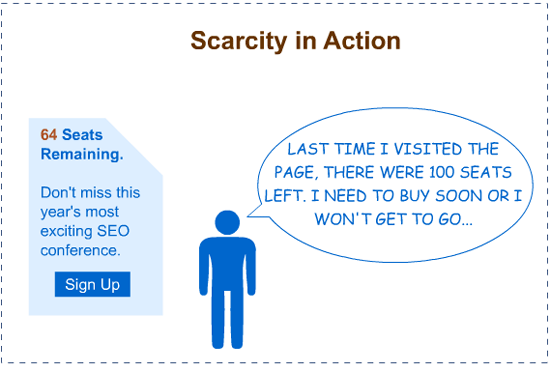
Scarcity becomes more powerful when it's clear that the resource is finite (houses are great for this reason) and when immediacy is added to the scarcity (as in the case of another buyer on the horizon). Auction sites like eBay combine the powers of these persuasion tactics with remarkable results.
Leveraging scarcity in web marketing:
- Offer a special version of your product for a limited time in limited quantities
- Feature messages like Expedia's - "only 2 tickets left at this price" - or Zappos' - "only 3 pairs left in this size" - next to results/products to help encourage timely conversion
- Create an incentive for the first X visitors who take an action; you'll likely get many more
- Show the number of people viewing an item right on the product page (e.g. "6 others currently on this page") to help create excitement and a feeling of immediacy (particularly for one-of-a-kind or limited quantity products)
Individually, these are powerful instruments of persuasion. Together, they're a marketing force to be reckoned with. Let's try an experiment and see if I can effectively employ the six principles as they related to SEOmoz (please note, I'm not normally this self-promotional, and this is meant somewhat tongue-in-cheek):
- This blog post is the result of many hours of studying, writing and illustrating. If it's helped your business in some way, we hope you'll say thanks by sharing it through tweets, links or an email to someone you think would appreciate the reference.
- Are you the kind of SEO who bases their decisions on data or gut feeling? Close your eyes for a minute and think. If you said "data," I'd urge you to check out the new Keyword Difficulty tool. It will help make decisions about where and how to compete from a much more data driven perspective.
- 2,426 search marketers on Facebook have become fans of SEOmoz. Won't you join them?
- Danny Dover is impossible not to like. Make Danny happy by following him on Twitter.
- The Search & Social Awards named SEOmoz the best SEO Blog, top SEO community and favorite SEO tool suite this year.
- This summer we're launching a new software suite and SEOmoz PRO prices are going up to $100, $500 and $2,000 per month (respectively). There's less than 60 days to get PRO at the current rates.
The next time you make a landing page or try to drive actions on the web, think about how you might leverage these principles of influence to improve your conversion rate.
As always, looking forward to your thoughts in the comments - I'd particularly love to see examples of the principles in action at on the web. It's something I wanted to do when authoring this post, but simply ran out of time.




Comments
Please keep your comments TAGFEE by following the community etiquette
Comments are closed. Got a burning question? Head to our Q&A section to start a new conversation.